Market Overview
The Global AI TRiSM Market is projected to reach
USD 2.6 billion in 2025 and grow at a compound annual
growth rate of 16.6% from there until 2034 to reach a
value of USD 10.3 billion.
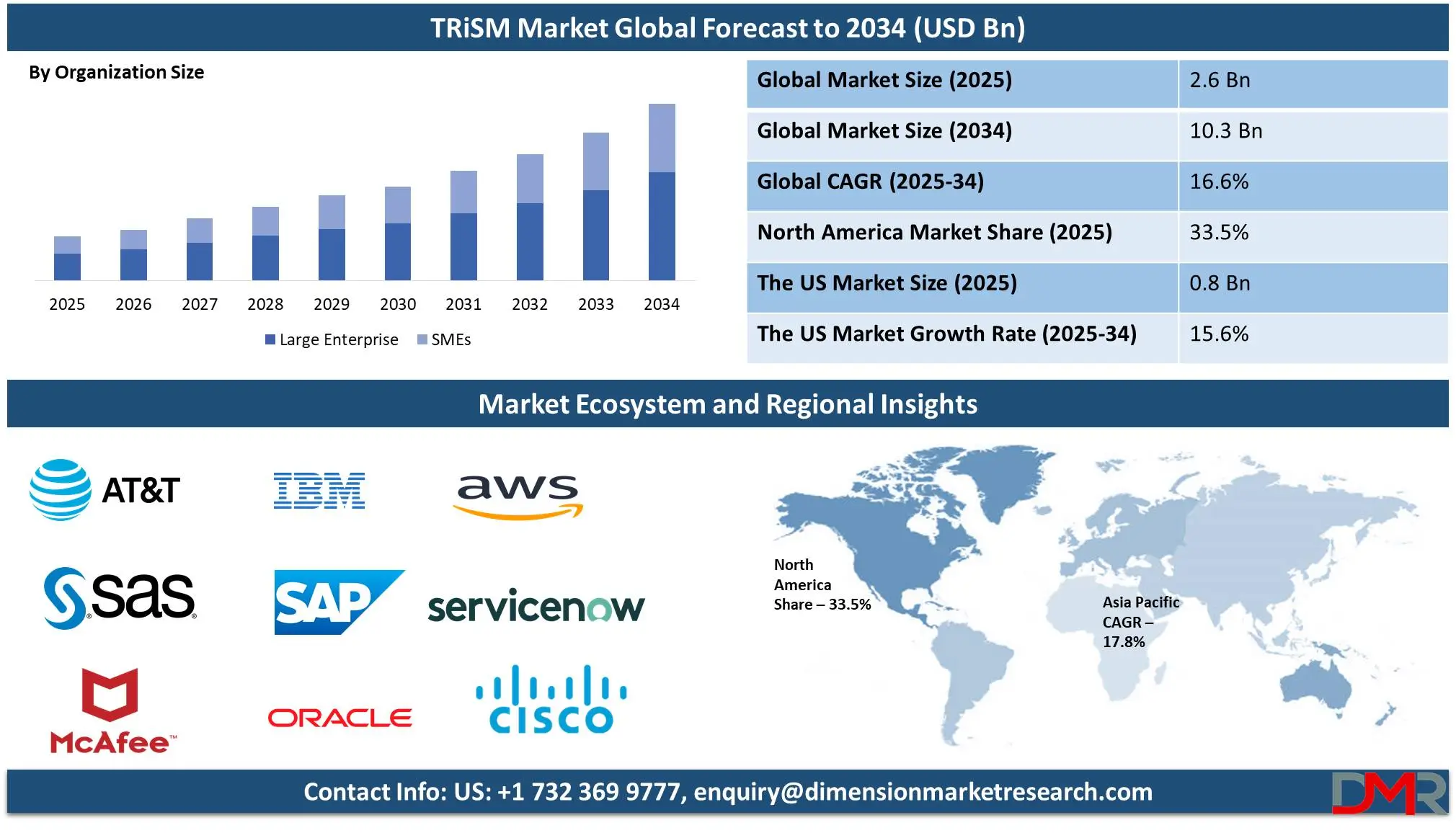
AI TRiSM (AI Trust, Risk, and Security Management) is an all-encompassing framework created to manage the complex aspects of artificial intelligence systems. From data collection & model development through deployment & monitoring, this comprehensive approach ensures AI technologies are trustworthy, secure, and accountable technologies. At its core, this framework focuses on fairness and transparency when making decisions to help build trust with stakeholders such as customers, regulators, and partners helping build confidence among these groups that may use the system.
By including these principles in development processes, organizations are better prepared against potential risks such as biased outcomes or security vulnerabilities that could arise in these systems.
As AI technologies become ingrained into daily life, the need for TRiSM has surged rapidly due to their growing adoption in areas like healthcare, finance, and transportation. Organizations are turning towards AI TRiSM as a risk reduction strategy, many adopting it to ensure their AI solutions not only remain efficient but are also fair & accountable to customers and stakeholders while adhering to evolving regulatory standards.
Further, trends have showcased the importance of AI TRiSM. Growing AI regulation is one of the primary influences behind its broad adoption; governments and regulatory bodies mainly prioritize ethical AI use with data privacy, fairness and transparency as their top concerns; initiatives such as the European Union's AI Act are setting global standards on how it should be managed, prompting organizations to use AI TRiSM to ensure compliance and reduce any legal or regulatory penalties.
Further, AI TRiSM promotes transparency by developing guidelines for explainable AI, making decision-making more understandable and accessible; this approach ensures both regulatory compliance and user and public trust in AI decision-making processes.
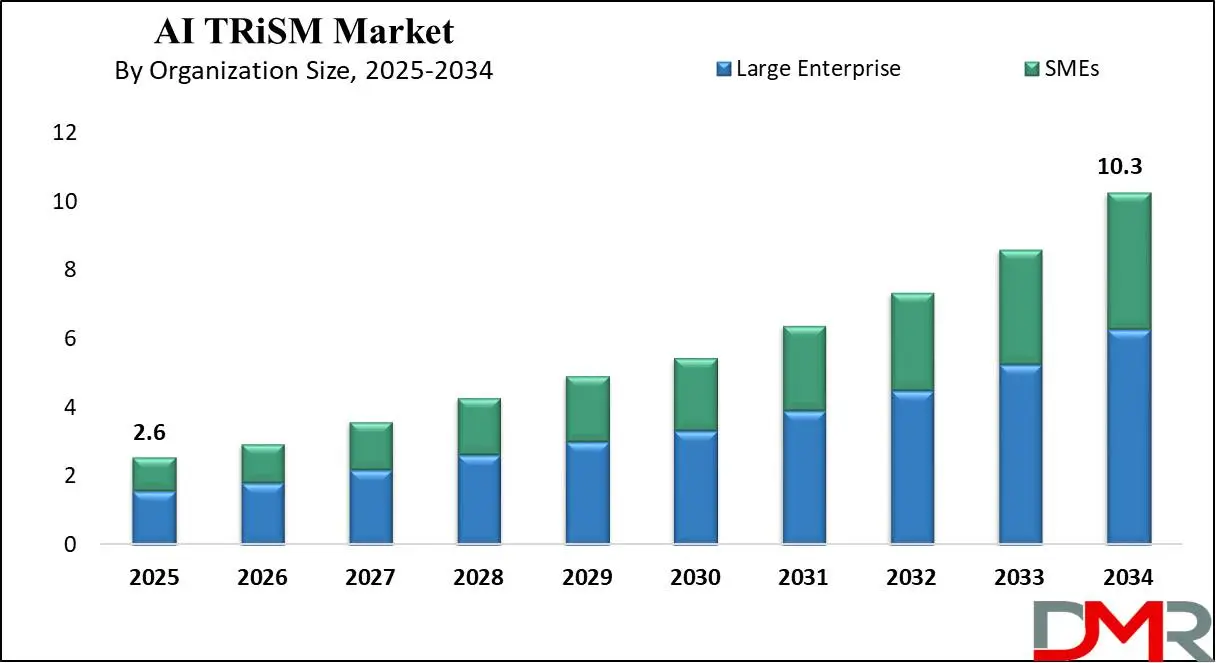
Also, events like AI usage on social media platforms such as Facebook or autonomous vehicles have highlighted some of the risks inherent to AI systems. High-profile incidents like biased AI algorithms in hiring tools or facial recognition software have highlighted this need, prompting organizations to adopt AI TRiSM practices to weaken against potential risks while providing ethical AI solutions that comply with relevant regulations and ensure their solutions meet ethical criteria.
The US AI TRiSM Market
The US AI TRiSM Market is projected to reach USD 0.8 billion in 2025 at a compound annual growth rate of 15.6% over its forecast period.
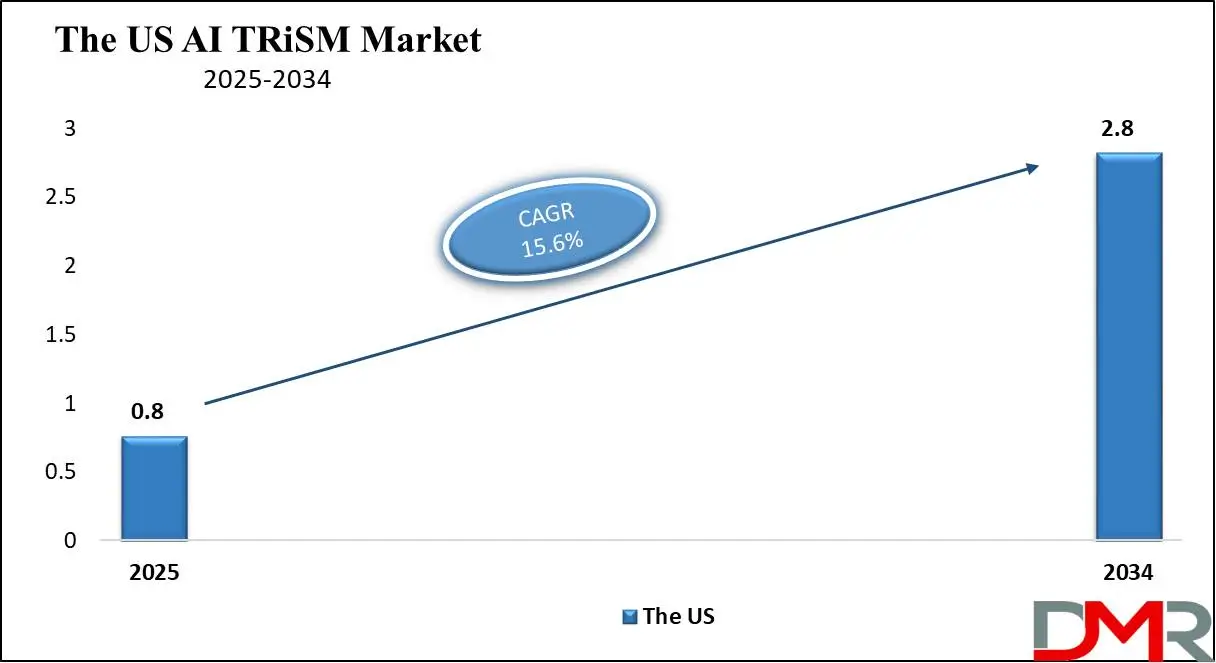
The US has significant growth opportunities in the AI TRiSM market due to its strong AI ecosystem, advanced regulatory frameworks, and growing focus on responsible AI. Growing investments in cybersecurity, bias detection, and AI governance drive demand. In addition, expanding AI adoption across healthcare, finance, and government sectors creates a need for robust risk management and transparency solutions.
Further, the market is driven by rapid development in AI adoption across industries, strict regulatory compliance requirements, and growing concerns over AI ethics and security. The demand for transparent and accountable AI systems fuels innovation in risk management solutions. However, challenges like high implementation costs, integration complexities with existing infrastructure, and a shortage of skilled professionals may slow widespread adoption, limiting market growth potential.
AI TRiSM Market: Key Takeaways
- Market Growth: The AI TRiSM Market size is expected to grow by 7.3 billion, at a CAGR of 16.6% during the forecasted period of 2026 to 2034.
- By Offering: The solution systems segment is anticipated to get the majority share of the AI TRiSM Market in 2025.
- By End Users: The IT & Telecom sector is expected to be leading the market in 2025
- By Organization Size: The Large enterprise segment is expected to get the largest revenue share in 2025 in the AI TRiSM Market.
- Regional Insight: North America is expected to hold a 33.5% share of revenue in the Global AI TRiSM Market in 2025.
- Use Cases: Some of the use cases of AI TRiSM include healthcare, finance, and more.
AI TRiSM Market: Use Cases
- Healthcare: In healthcare, AI TRiSM ensures that AI-driven systems, like diagnostic tools or patient management software, are transparent and accountable. It helps minimize risks like bias in medical diagnoses, ensuring that AI decisions are fair, explainable, and comply with privacy regulations like HIPAA.
- Finance: AI TRiSM is important in financial institutions to manage risks linked with AI models used for credit scoring, fraud detection, or investment decisions. It ensures that these systems are transparent, reduce biases, comply with financial regulations, and are secure from cyber threats.
- Autonomous Vehicles: In autonomous vehicles, AI TRiSM helps ensure that AI systems are safe and reliable by providing robust risk assessments. It ensures that the decision-making of autonomous systems is explainable, minimizing the likelihood of accidents and ensuring compliance with safety standards.
- Hiring and Recruitment: AI TRiSM is used in recruitment tools to prevent bias in hiring decisions, ensuring fairness in the selection process. It promotes transparency in how AI evaluates candidates and ensures that AI models comply with labor laws and anti-discrimination regulations.
Stats & Facts
- AI TRiSM addresses every stage of AI's lifecycle, from data collection and deployment through monitoring with special consideration given to fairness, transparency, risk management, and security at every turn, taking into account regulatory needs, ethical considerations, and organizational accountability to create AI systems that are both reliable and responsible.
- This framework focuses on exploitability and fairness to build trust with stakeholders such as customers and regulators. Transparent processes reduce concerns over biased or unethical practices that could compromise customer loyalty or brand reputation and ensure successful AI adoption solutions.
- Organizations looking to adopt AI TRiSM should assemble multidisciplinary teams consisting of data scientists, ethicists, legal experts, and cybersecurity specialists, which allows organizations to assess AI system performance while meeting ethical guidelines, risk management best practices, and incident handling standards.
- An AI governance body is important in overseeing AI initiatives, ensuring TRiSM principles are upheld across projects. Furthermore, this framework facilitates agile processes that adapt to emerging technologies and changing regulatory environments, thus guaranteeing long-term sustainability.
- Businesses using AI TRiSM can design, deploy, and manage AI systems with trust management in mind to increase long-term viability while mitigating risks from regulatory fines, legal challenges, or security breaches. This comprehensive approach ensures the long-term viability of solutions while minimizing regulatory fines, legal challenges, or security breaches.
Market Dynamic
Driving Factors in the AI TRiSM Market
Regulatory Pressure and ComplianceAs governments around the world implement stricter regulations on AI usage, like the European Union's AI Act, organizations are compelled to adopt AI TRiSM to ensure compliance. These regulations focus on ethical AI, data privacy, and transparency, pushing businesses to implement robust frameworks that align with legal requirements. As AI adoption increases, so does the demand for frameworks like AI TRiSM to lower legal and reputational risks, driving growth in the market. The increasing focus on AI accountability and fairness further accelerates the adoption of AI TRiSM solutions
Rising Cybersecurity Threats
The increasing dependency on AI systems across many industries has led to growing cyberattacks and data breaches targeting AI models. To protect sensitive data and ensure the security of AI systems, organizations are turning to AI TRiSM for complete risk management and cybersecurity strategies. AI TRiSM helps prevent malicious attacks, model manipulation, and vulnerabilities within AI algorithms, making it a vital component in securing AI systems. As cybersecurity threats evolve, the demand for AI TRiSM solutions to safeguard AI deployments continues to rise.
Restraints in the AI TRiSM Market
High Implementation Costs
Implementing AI TRiSM requires higher investment in infrastructure, talent, and ongoing monitoring. Organizations need to hire specialized professionals like data scientists, ethicists, and cybersecurity experts to build and maintain these frameworks. Smaller businesses or those with limited resources may find it difficult to afford the cost of integrating AI TRiSM, which could slow down market adoption. The complexity & ongoing nature of implementing these systems can be a financial burden, mainly for startups and mid-sized companies.
Lack of Standardization
The absence of universally accepted standards for AI TRiSM creates a challenge for businesses looking to adopt the framework. Different industries and regions may have different interpretations of what constitutes trustworthy, secure, and ethical AI. Without standardized guidelines, organizations may struggle to create a consistent approach to AI TRiSM, leading to fragmentation in the market, which could delay widespread adoption as businesses seek clear, globally recognized benchmarks.
Opportunities in the AI TRiSM Market
Growing Demand for Ethical AI Solutions
As AI becomes more integrated into critical sectors like healthcare, finance, and transportation, there is a major opportunity for AI TRiSM to address the rising demand for ethical AI practices. Consumers & regulators are mainly concerned about fairness, bias, and transparency in AI systems, creating a market opportunity for organizations to adopt AI TRiSM frameworks to build trust. This growing focus on ethical AI presents an opportunity for businesses to differentiate themselves by adopting AI TRiSM, ensuring responsible and accountable AI deployment.
Expansion in Emerging Markets
Emerging markets, particularly in Asia and Africa, are rapidly adopting AI technologies in sectors like agriculture, retail, and public services. As AI adoption grows, there is a major opportunity for AI TRiSM to help organizations in these regions address risks related to data privacy, security, and regulatory compliance. The growing emphasis on sustainable and inclusive AI solutions in these markets provides an opportunity for AI TRiSM vendors to expand their reach and establish a presence in these developing economies, where the demand for secure and ethical AI frameworks is on the rise.
Trends in the AI TRiSM Market
Integration of AI TRiSM with AI Governance Platforms
A recent trend in the AI TRiSM market is the integration of AI TRiSM principles with broader AI governance platforms. Organizations are mainly adopting AI governance tools that use risk management, transparency, and compliance features, providing a more holistic approach to managing AI systems. These platforms help automate compliance checks, monitor AI performance, and ensure ethical AI usage, reducing the manual burden on organizations.
Increased Focus on Explainable AI (XAI)
Another emerging trend in the AI TRiSM market is the growing emphasis on explainable AI (XAI) to enhance transparency and trust. As AI systems become more complex, organizations are prioritizing XAI techniques to ensure that AI models provide understandable explanations for their decisions, which is particularly relevant in industries like healthcare and finance, where decision-making needs to be clear and justifiable. The demand for AI TRiSM frameworks that support XAI is driving the market as organizations seek to build more trustworthy AI systems that can be easily interpreted and audited.
Research Scope and Analysis
By Offering
In 2025, solutions will likely dominate the AI TRiSM market with the largest share. AI TRiSM solutions are customized software tools designed to support machine learning (ML) practitioners and software developers who monitor, assess, interpret, and gain insights into ML models being created before final deployment. These solutions play a major role in safeguarding AI systems by providing transparency regarding model predictions and making sure stakeholders can easily comprehend AI decision-making processes. AI TRiSM solutions are mostly used during software development to debug AI models instantly, ensure their quality, provide performance analytics, and distill complex logic into clear actionable insights. By including these solutions in their development workflow, organizations can ensure their AI models meet accuracy, reliability, and ethical compliance before being put into real-world use.
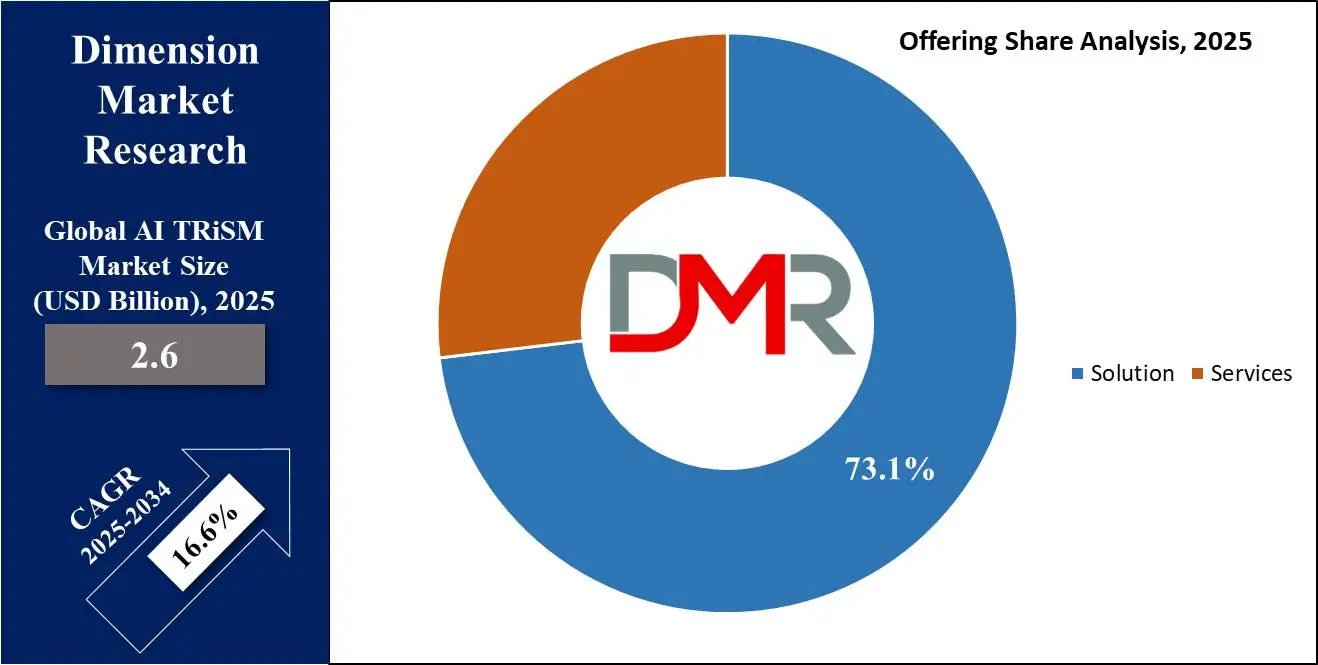
Further, in the coming years, the services segment is predicted to experience impressive expansion, with both professional and managed services related to AI TRiSM solutions' deployment and implementation. Since AI TRiSM solutions are still relatively new on the market, there remains limited understanding as to how best to use them effectively and integrate them easily with existing systems. As such, vendors have begun providing cost-effective deployment and implementation services that enable organizations to integrate AI TRiSM into their processes.
Vendors also majorly provide post-sale support, typically including consultation services that provide expert guidance for using solutions effectively. Consultations through various communication channels such as video calls, emails, or phone calls provide businesses with the support necessary to fully utilize AI TRiSM solutions. As more businesses look to optimize their AI systems, demand for these services will likely increase further, fueling growth in this segment.
By Type
Explainability is projected to account for the biggest revenue share of the AI TRiSM market by 2025. As AI systems become highly prevalent in organizations around the world, organizations are becoming aware of the need to build trust in these technologies, mainly for use in fields like healthcare, finance, and autonomous driving. AI decisions mostly have direct repercussions for human lives and well-being, so transparency and trustworthiness are of utmost importance in these sectors. Furthermore, explainability not only promotes these values but also ensures compliance with regulations designed to encourage responsible AI usage.
Prioritizing explainability can support businesses to demonstrate accountability and ensure that AI systems operate transparently and fairly, which focus on clear decision-making processes has led to rapid expansion in the explainability market as companies invest in AI TRiSM solutions that help navigate AI ethics, governance, and risk mitigation issues.
Further, ModelOps is expected to experience impressive growth over the forecast period due to increasing demand for efficient AI and ML model lifecycle management solutions. ModelOps (Model Operations) refers to the ongoing management of AI models from development through testing, deployment, and monitoring, along with ongoing maintenance. As AI models become more complex and integrated into various business operations, demand for effective ModelOps solutions has skyrocketed. One factor driving this growth is an explosion of AI models across industries.
As more organizations adopt AI, the need to effectively manage AI models to ensure continued performance and reliability has become essential. Their widespread usage across various business applications has created an increased need for robust ModelOps solutions that are further expanding the market.
By Deployment
The on-premises AI TRiSM solutions will account for the largest share of revenue in the market in 2025. Businesses often prefer these solutions due to direct control over infrastructure, data storage, and security. By choosing on-premises deployment, organizations can personalize their security measures to their exact requirements and regulatory standards, guaranteeing compliance with strict industry standards, which is mainly important in highly regulated fields like finance and healthcare, where handling sensitive data requires maximum supervision and stringent security protocols. Companies can benefit from keeping AI TRiSM solutions in-house to minimize dependence on external service providers, mitigate data exposure risks, and ensure full visibility into their AI systems.
Further Cloud technology is expected to experience exponential growth over the coming years due to its flexibility and scalability. Cloud-based AI TRiSM solutions allow organizations to gain access to critical security and risk management capabilities from any location, making remote collaboration and live monitoring effortless. Businesses with global operations will find cloud deployment especially advantageous, as it allows centralized security management across locations. One of the main advantages of AI TRiSM solutions in cloud deployment is cost efficiency.
Businesses can opt for a pay-as-you-go model instead of investing heavily in physical infrastructure and its ongoing maintenance and only paying for resources they use. Companies looking to efficiently manage budgets while taking advantage of AI TRiSM advancements will find this approach particularly attractive. Cloud solutions also receive regular updates, giving organizations access to the most up-to-date security enhancements without manual system upgrades. As more companies prioritize agility and cost savings, demand for AI TRiSM solutions in the cloud should increase steadily.
By Organization Size
Large enterprises will capture the highest revenue share by 2025 due to the broad implementation of AI technologies across their organizations from marketing and sales, finance and risk management, etc. AI TRiSM solutions can help large enterprises meet this increased dependency on AI technologies by providing tools that manage data privacy along with ensuring model explainability and fairness within AI models. Large enterprises also recognize any associated risks, like biases, security vulnerabilities or explainability issues that arise, as well as provide regulatory compliance.
Further, the Small & Medium Enterprise (SME) sector is predicted to experience rapid expansion over the forecast period, as artificial intelligence (AI), mainly becomes prevalent and companies recognize the significance of building trust amongst stakeholders. Small businesses must demonstrate their dedication to ethical AI practices and effective security measures to build trust among customers, partners, and regulatory authorities, thereby contributing to both their credibility and competitive edge in the market.
As SMEs are an important driver of economic growth and innovation, AI technologies are becoming more integral to business operations across multiple industries; accordingly, SMEs are realizing they must adopt comprehensive AI TRiSM practices to navigate responsibly the complexities associated with their deployment.
By Application
AI TRiSM market will see cybersecurity dominate in 2025 as growth in frequent and special cyber attacks targeting organizations of all kinds across all industries. As businesses transition towards digital transformation, the attack surface available for cybercriminals to exploit has grown substantially, making cybersecurity an absolute priority. AI TRiSM solutions are key for strengthening threat detection, analysis, and response processes.
By harnessing AI, these solutions can quickly analyze large volumes of data to quickly detect patterns that indicate security breaches and automate threat responses, decreasing attackers' window of opportunity. Due to the growing complexity of cyber threats such as advanced persistent threats (APTs), ransomware, phishing attacks, and zero-day attacks, traditional security measures are no longer sufficient to combat them. Artificial intelligence-powered solutions offer continuous monitoring and real-time analysis capabilities, which help organizations ward off breaches before they occur.
In addition, fraud detection and prevention should experience substantial growth over the coming years. One factor driving this growth is increasing awareness within organizations of the potential dangers posed by biased AI systems, which could cause unfair discrimination and inaccurate results. As governments impose regulations requiring businesses to address AI bias, demand for solutions that detect and mitigate it has increased exponentially.
Such solutions are essential in ensuring AI systems operate fairly and transparently. Technological advances are making these solutions more accessible, helping organizations detect and avoid biased outcomes. Emerging technologies play an instrumental role in improving our ability to detect AI bias, fueling its expansion within the AI TRiSM market.
By End User
Based on end users, the IT and telecom industries are expected to generate the highest revenue in the Artificial Intelligence TRiSM market in 2025. AI technology is transforming IT operations by optimizing and automating IT infrastructure, increasing overall business efficiency, and personalizing customer experiences through personalization. AI also plays an important role in managing large amounts of data and conducting real-time analytics that support business processes, making its adoption even faster in IT and telecom industries.
As AI usage expands, so do its risks, like data breaches, leaks, and cyber threats. IT companies are responding to this growing concern by adopting AI TRiSM solutions to ensure secure deployment, monitor AI-driven applications, and protect sensitive data. Such regulatory and security measures help businesses maintain trust among customers while protecting proprietary products, further fueling demand for AI TRiSM within the sector.
Also, healthcare sector AI TRiSM adoption is projected to experience rapid expansion over the coming years. AI is transforming healthcare by analyzing medical data, automating administrative tasks, aiding clinical decision-making processes, predicting disease outbreaks, and increasing diagnostic accuracy. AI advancements are revolutionizing patient experiences and simplifying medical practices, significantly improving overall patient experiences while simultaneously streamlining medical practices.
Yet as artificial intelligence (AI) continues its role in healthcare, trust, risk management, and security become even more crucial. Maintaining fair, impartial, and secure AI systems is key to compliance with healthcare regulations and protecting patient data. Healthcare organizations have increasingly invested in AI TRiSM solutions as a means of mitigating risks posed by AI-powered tools while assuring they operate responsibly demand is expected to only continue growing with increased use of AI in medical fields.
The AI TRiSM Market Report is segmented on the basis of the following
By Offering
By Type
- Explainability
- ModelOps
- Data Protection
- Data Anomaly Detection
- AI Application Security
By Deployment
By Organization Size
By Application
- Fraud Detection & Prevention
- Cybersecurity
- Compliance Management
- Data Privacy Management
- Others
By End User
- IT & Telecom
- BFSI
- Retail & E-commerce
- Healthcare
- Manufacturing
- Government & Defense
- Others
Regional Analysis
The region with the largest share in the AI TRiSM MarketNorth America is anticipated to lead the AI TRiSM market in 2025
with 33.5% of the market share, due to the presence of major technology firms at the forefront of AI innovation. These industry leaders have built up formidable AI capabilities, like advanced cloud platforms and governance frameworks, that give them a competitive advantage in their industries.
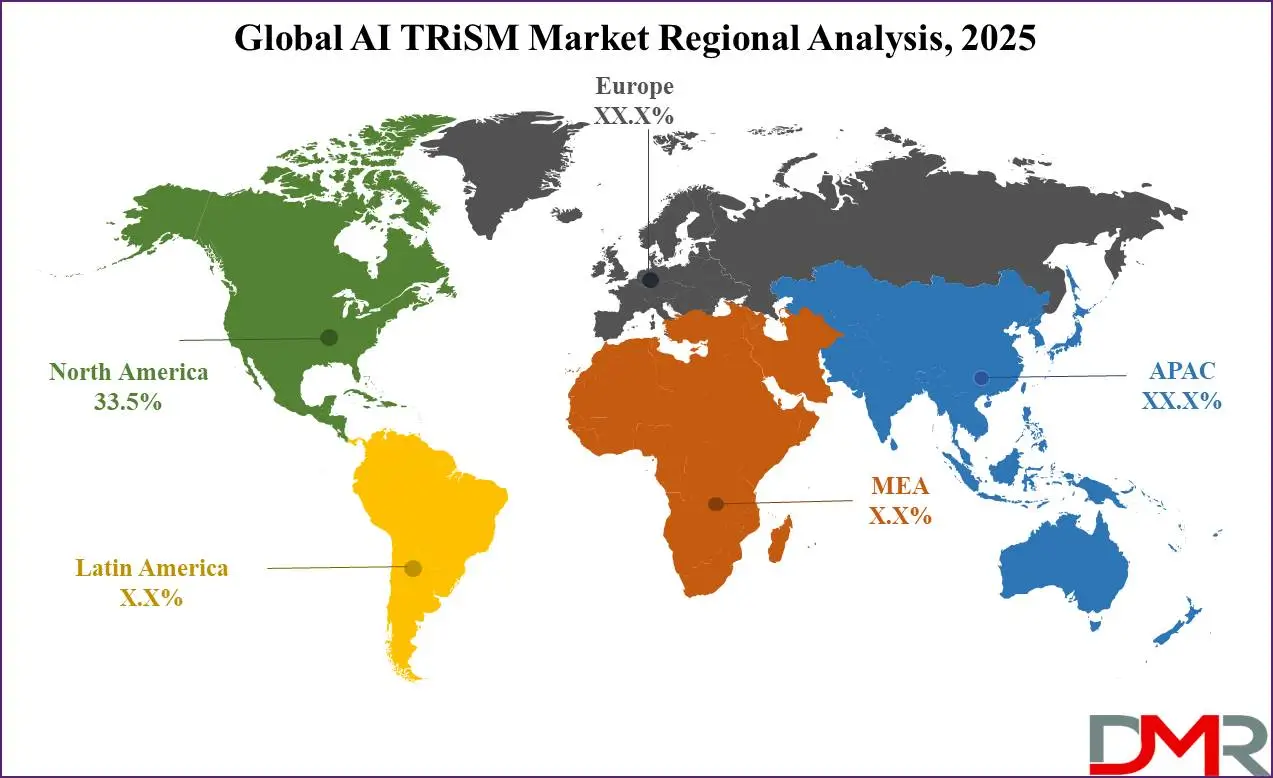
Their ability to develop AI systems that not only are high-performing and reliable but also are compliant with ever-evolving regulations is an asset to their market position. Reliability and compliance with regulatory standards make their solutions more appealing to businesses looking for trustworthy AI applications, drawing customers in while keeping existing ones happy, along with growth in investor trust in these businesses. With continued advancements and strong foundations for AI development in North America, its leadership of TRiSM market looks set to endure.
The fastest-growing region in the AI TRiSM MarketAsia Pacific is projected to experience the fastest growth of any AI TRiSM market over the coming years, driven by the large adoption of AI-powered solutions across various industries like finance, retail, transportation, healthcare, agriculture and manufacturing. Governments and policymakers in this region are actively investigating AI's role in driving economic and social benefits, setting ethical guidelines and best practices focused on helping businesses and communities maximize AI's potential while mitigating risks or unintended challenges posed by adopting it responsibly while safeguarding individuals or organizations against unintended results or unwanted results that could arise from adopting it irresponsibly.
By Region
North America
Europe
- Germany
- The U.K.
- France
- Italy
- Russia
- Spain
- Benelux
- Nordic
- Rest of Europe
Asia-Pacific
- China
- Japan
- South Korea
- India
- ANZ
- ASEAN
- Rest of Asia-Pacific
Latin America
- Brazil
- Mexico
- Argentina
- Colombia
- Rest of Latin America
Middle East & Africa
- Saudi Arabia
- UAE
- South Africa
- Israel
- Egypt
- Rest of MEA
Competitive Landscape
The AI TRiSM market is highly competitive, with various technology providers striving to provide advanced solutions for trust, risk, and security in AI systems. Companies are constantly innovating to enhance AI governance, transparency, and compliance with evolving regulations. The market sees strong competition in areas like cybersecurity, bias detection, explainability, and AI lifecycle management. Partnerships, mergers, and acquisitions are common strategies used to expand capabilities and market reach. With increasing demand for responsible AI, businesses are focusing on developing scalable and cost-effective solutions that help organizations secure, monitor, and optimize their AI-driven operations.
Some of the prominent players in the global AI TRiSM are
- AT&T Inc
- IBM Corp
- SAP SE
- SAS
- Hewlett Packard Enterprise Development LP
- ServiceNow Inc.
- Cisco System
- AWS
- Oracle Corp
- McAfee
- Other Key Players
Recent Developments
- In February 2025, webA announced that ŌURA will be using webAI on-device AI services to deliver personalized health insights to Oura Members. ŌURA, known for its innovative health-tracking smart ring, is in the lead in building AI to power accurate, actionable insights into its members' well-being, as it will ensure better privacy, faster insights, and highly customizing recommendations—prioritizing data security and reducing latency.
- In January 2025, Gorilla Technology Group Inc. unveiled that they are now advancing to the design and development phase, which involves implementing advanced customization and integration solutions that will transform Thailand into Southeast Asia's hub for AI-powered tourism safety.
- In November 2024, AppSOC launched its AI Security & Governance solutions customized for the Databricks Data Intelligence Platform, which introduces robust security, governance, and compliance capabilities for organizations using Databricks to develop and deploy AI models at scale. The integration is developed to address the growing need for securing AI models and workflows, allowing Databricks users to innovate confidently while maintaining stringent governance standards.
- In July 2024, The Organisation for Economic Co-operation and Development (OECD) introduced a pilot phase to monitor the application of the Hiroshima Process International Code of Conduct for Organizations Developing Advanced AI Systems, which will test a reporting framework intended to gather information about how organizations developing advanced artificial intelligence (AI) systems align with the actions of the Code of Conduct and is a significant milestone under the G7's ongoing commitment to promoting safe, secure and trustworthy development, deployment and use of advanced AI systems.
Report Details
| Report Characteristics |
| Market Size (2024) |
USD 2.6 Bn |
| Forecast Value (2033) |
USD 10.3 Bn |
| CAGR (2024-2033) |
16.6% |
| Historical Data |
2018 – 2023 |
| The US Market Size (2024) |
USD 0.8 Bn |
| Forecast Data |
2025 – 2033 |
| Base Year |
2023 |
| Estimate Year |
2024 |
| Report Coverage |
Market Revenue Estimation, Market Dynamics, Competitive Landscape, Growth Factors and etc. |
| Segments Covered |
By Offering (Solution and Services), By Type (Explainability, ModelOps, Data Protection, Data Anomaly Detection, and AI Application Security), By Deployment (Cloud and On-Premises), By Organization Size (Large Enterprises and SMEs), By Application (Fraud Detection & Prevention, Cybersecurity, Compliance Management, Data Privacy Management, Others), By End User (IT & Telecom, BFSI, Retail & E-commerce, Healthcare, Manufacturing, Government & Defense, and Others) |
| Regional Coverage |
North America – The US and Canada; Europe – Germany, The UK, France, Russia, Spain, Italy, Benelux, Nordic, & Rest of Europe; Asia- Pacific– China, Japan, South Korea, India, ANZ, ASEAN, Rest of APAC; Latin America – Brazil, Mexico, Argentina, Colombia, Rest of Latin America; Middle East & Africa – Saudi Arabia, UAE, South Africa, Turkey, Egypt, Israel, & Rest of MEA
|
| Prominent Players |
AT&T Inc, IBM Corp, SAP SE, SAS, Hewlett Packard Enterprise Development LP, ServiceNow Inc., Cisco System, AWS, Oracle Corp, McAfee, and Other Key Players |
| Purchase Options |
We have three licenses to opt for: Single User License (Limited to 1 user), Multi-User License (Up to 5 Users) and Corporate Use License (Unlimited User) along with free report customization equivalent to 0 analyst working days, 3 analysts working days and 5 analysts working days respectively. |
Frequently Asked Questions
The Global AI TRiSM Market size is expected to reach a value of USD 2.6 billion in 2025 and is expected to reach USD 10.3 billion by the end of 2034.
North America is expected to have the largest market share in the Global AI TRiSM Market with a share of about 33.5% in 2025.
The AI TRiSM Market in the US is expected to reach USD 0.8 billion in 2025.
Some of the major key players in the Global AI TRiSM Market are IBM, SAP, AWS, and others.
The market is growing at a CAGR of 16.6 percent over the forecasted period.